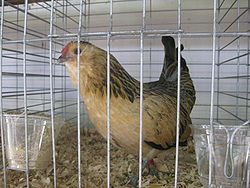
Belgian Bearded d'Anvers
Encyclopedia

Breed
A breed is a group of domestic animals or plants with a homogeneous appearance, behavior, and other characteristics that distinguish it from other animals or plants of the same species. Despite the centrality of the idea of "breeds" to animal husbandry, there is no scientifically accepted...
of bantam
Bantam (chicken)
A bantam is a small variety of poultry, especially chickens. Etymologically, the name bantam is derived from the city of Bantam - currently known as "Banten Province" or previously "Banten Residency" - once a major seaport, in Indonesia...
chicken
Chicken
The chicken is a domesticated fowl, a subspecies of the Red Junglefowl. As one of the most common and widespread domestic animals, and with a population of more than 24 billion in 2003, there are more chickens in the world than any other species of bird...
from Belgium
Belgium
Belgium , officially the Kingdom of Belgium, is a federal state in Western Europe. It is a founding member of the European Union and hosts the EU's headquarters, and those of several other major international organisations such as NATO.Belgium is also a member of, or affiliated to, many...
. Also called the Antwerp Belgian, both names refer to the breed's origin in Antwerp (the French
French language
French is a Romance language spoken as a first language in France, the Romandy region in Switzerland, Wallonia and Brussels in Belgium, Monaco, the regions of Quebec and Acadia in Canada, and by various communities elsewhere. Second-language speakers of French are distributed throughout many parts...
version being Anvers). The d'Anvers is a true bantam, having no large counterpart from which it was miniaturized. Males weigh 740 grams (26 ounces), and hens weigh 625 grams (22 ounces).
The Bearded d'Anvers is closely related to, and may the be the predecessor of, the Belgian Bearded d'Uccle
Belgian Bearded d'Uccle
The Belgian Bearded d'Uccle , or Barbu D'Uccle in French, is a breed of bantam chicken originating from the town of Uccle on the outskirts of Brussels, Belgium...
. The exact time of origin for the breed is unknown, but it is likely that it has existed since at least the 17th century. By the middle of the 19th century, several color varieties were in development. The early 20th century saw a considerable surge in interest by breeders, and it was exported to the U.S. and other places abroad in the first of that century. It was first accepted in to the Standard of Perfection of the American Poultry Association
American Poultry Association
The American Poultry Association is the oldest poultry organization in the North America. Founded in 1873, and incorporated in Indiana in 1932 The first American poultry show was held in 1849, and the APA was later formed in response to the burgeoning need for an overseeing body to set standards...
in 1949. Also accepted by the American Bantam Association, it is classed as one of the Rose Comb, Clean Legged bantams.
The Bearded d'Anvers is a purely ornamental breed, kept either as pets or by poultry fanciers
Animal fancy
Animal fancy is a hobby involving the appreciation, promotion, or breeding of pet or domestic animals.Fancy may include ownership, showing, trialling and other competitions, breeding and judging. Hobbyists may simply collect specimens of the animal in appropriate enclosures, such as aquaria and...
for showing
Livestock show
A livestock show is an event where livestock are exhibited and judged on certain phenotypical breed traits as specified by their respective breed standard. Species of livestock that may be shown include pigs, cattle, sheep, goats, horses, llamas and alpacas. Poultry such as chickens, geese, ducks,...
. The hens of the breed are very friendly to humans, however the roosters may be aggressive to people. Most Bearded D'Anvers live longer and healthier if keep free-range or in an open space with no crowding. Its plumage can by one of fourteen varieties recognized in competition, ranging from Porcelain to Quail (one of the more common for the breed). It is a diminutive bird with a large, round breast that juts forward and an arching tail. As its name implies, the d'Anvers has a profuse beard of feathers that covers the earlobes. It has a small rose comb
Comb (anatomy)
Anatomically, a comb is a fleshy growth, caruncle, or crest on the top of the head of gallinaceous birds, most notably turkeys, pheasants, and domestic chickens...
and small or nonexistent wattles
Wattle (anatomy)
A wattle is a fleshy dewlap or caruncle hanging from various parts of the head or neck in several groups of birds, goats and other animals. In some birds the caruncle is erectile tissue.The wattle is frequently an organ of sexual dimorphism...
. Temperamentally, the breed is very amicable, and bears confinement
Chicken coop
A chicken coop is a building where female chickens are kept. Inside there are often nest boxes for egg laying and perches on which the birds can sleep, although coops for meat birds seldom have either of these features....
well. Hens lay small white eggs
Egg (food)
Eggs are laid by females of many different species, including birds, reptiles, amphibians, and fish, and have probably been eaten by mankind for millennia. Bird and reptile eggs consist of a protective eggshell, albumen , and vitellus , contained within various thin membranes...
and will go broody.

